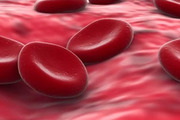We all know that oxygen is the key to living. It's in the air you breathe, in your lungs and in your blood. What you might not know is how oxygen gets into your blood and how the blood carries oxygen through your body.
Blood and Oxygen - How It Works
You breathe air in through your nose and mouth. It makes its way into your lungs and dissolves in the water lining of the alveoli. Oxygen then clings to red blood cells as they pass through the alveolar capillaries - now the oxygen is in the blood.
 Red blood cells
Red blood cells
Blood and Oxygen - Types of Blood Vessels
Three types of blood vessels carry blood from your lungs to every cell in your body.
- Arteries - Arteries have muscular walls that pump oxygen-filled blood away from your heart to the tissues and organs, like the brain, kidneys and liver. Arteries get smaller as they get further from your heart. At their smallest point, arteries become capillaries.
- Capillaries - Capillaries are the tiniest blood vessels. They connect arteries to veins.
- Veins - Veins are what bring the "used" blood back to your heart.
.jpg)
Blood and Oxygen - Did U Know?
- The only part of your body that has no blood supply is the cornea in the eye. It takes in oxygen directly from the air.
- A severe sunburn damages the blood vessels so badly that it takes four to 15 months for them to return to their normal condition.
- The human heart creates enough pressure to squirt blood 30 feet (nine meters) out of the body.
Related Stories:
- The Ins and Outs of the Heart
- The Lowdown on Heart Disease
- The Science of Scabs
- More Scientific Facts in The Lab!

































